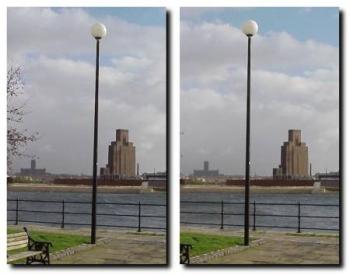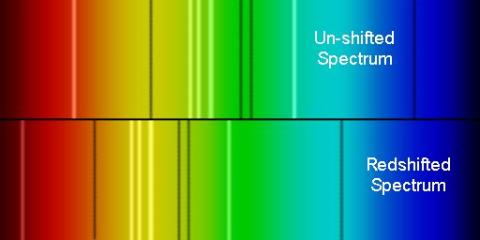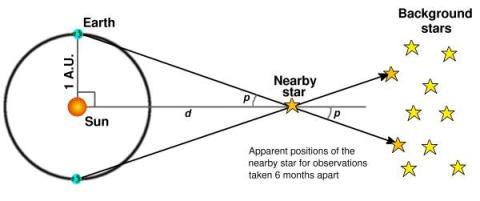Measuring distances in astronomy is difficult but crucial. We need to know how far away objects are to look at the differences between them. Two objects can look different but be very similar, with one further away than the other. This can make them challenging to study.
By knowing the distance to an object, we can learn about its actual size. We can measure the size an object takes up in the sky. We need to know how far away it is to work out its actual size. The further away an object is, the smaller it looks. An interesting example of this is that we can see planets in the night sky. They often look like stars but slightly bigger and brighter. Planets are much smaller than stars but are also much closer, so they appear bigger.
Knowing the distance to an object can also tell us about the energy it produces. We see most of this energy as light and can measure it using the luminosity. The further away something is, the fainter it seems to be. This makes it look less energetic. If we know how far away it is, we can work out how much energy it actually generates. We can then compare objects like stars. These can often look the same brightness but actually create different amounts of energy and light. This helps us to understand the physics of what makes them work.
The constellation of Orion has 3 stars in a row, making up "Orion's Belt". They look about the same brightness, but the middle one is twice the distance of the others. It is just much brighter.

- How do we measure distance?
Knowing the distance to objects in space is important. However, measuring it is also very hard—you can't just use a ruler! Astronomers have created a range of ways to measure the distance to objects in space.
Image CreditThis work by The Schools' Observatory is licensed under All rights reserved
CreditThis work by The Schools' Observatory is licensed under All rights reservedThe ways we measure distance fall into 2 types:
- Direct methods: These measure the distance to the object directly. There is no need to compare it to anything else. An example is measuring the distance to the Moon. We can shine a laser from the Earth towards the Moon. It is reflected back off special mirrors left by the astronauts who went to the Moon. The time the light travels to the Moon and back is then measured to give a distance.
- Relative methods: With these methods, you can only measure relative distances. For example, you might be able to say that Star A is 4 times further away than Star B. But you can't know how far that is as a distance, like in kilometres.
Of course, if you can measure the distance to Star A using a direct method, you can work out a distance to Star B. This is called calibration.
Sometimes, a relative method has to be calibrated by another relative method, which is calibrated by a direct one. When there are several stages or "steps" like this, it is sometimes called the Distance Ladder.
The table below shows examples of methods astronomers use to work out the distance to objects in space.
Method Kind of object Typical Distances Direct or Relative Radar The Moon and nearby planets like Mars. Millions to 100s of millions of km Direct Parallax Nearby stars Up to a few 100 light-years Direct "Standard Candle" stars Many stars and some nearby galaxies Depending on the kind of star, these can be used to find distances of many millions of light-years Relative Redshift Distant galaxies Right to the most distant galaxies, 1000s of millions of light-years away Relative - Parallax Measurements
- Image
 CreditThis work by The Schools' Observatory is licensed under All rights reserved
CreditThis work by The Schools' Observatory is licensed under All rights reservedParallax in action Parallax is one of the most important distance measurement methods used by astronomers. It can only be used for nearby stars, but it is very accurate.
The method measures how nearby objects move against the background of more distant objects. You can try this yourself by looking at a nearby lamppost against a building in the background. When you move position, the distance between the lamppost and the background building changes.
You can also see this effect by stretching out your arm while holding a pencil. If you close one eye and move your head from side to side, see how the pencil appears to move against the wall behind it.
The same effect can be used as the Earth orbits around the Sun. We look at the position of nearby objects when we are on one side of our orbit. We then wait 6 months and look again when we are on the other side of the orbit. Nearby planets and stars appear to move against the background. We can measure the movement to work out the distance because we know how our position has changed.
- Standard Candles
There are many types of stars in space. Some of these stars are easily recognisable and always have the same brightness. If you were to put two of these stars side-by-side, it would be hard to tell them apart.
Stars like this are called Standard Candles.
Standard candles are important in astronomy. They allow us to measure distance. If you have two stars of the same type, but one is further away than the other, it looks fainter. Knowing that they should be the same brightness allows us to work out the distances between them.
There are different kinds of Standard Candle stars. A type called Cepheid variable stars was used to show that the Universe contained many galaxies, not just our own. The most famous type today is probably type Ia supernovae. These allow us to measure the distance to galaxies, millions of light years away.
Image CreditThis work by The Schools' Observatory is licensed under All rights reserved
CreditThis work by The Schools' Observatory is licensed under All rights reserved- Redshift
Most galaxies appear to be moving away from us. This means that the light from them is "stretched" slightly and appears a bit redder than it would otherwise do.
This is similar to what happens to sound. Imagine that a fire engine is driving past you with its siren on. When it is moving towards you, the siren it quite high-pitched. When it is moving away from you, the pitch drops, and it sounds lower. With light, "lower" means more red and "higher" means more blue.
From studying lots of galaxies we know the further away a galaxy is, the more its spectrum is redshifted. This is because the Universe is expanding. This means astronomers can use redshift to work out the distance to a galaxy.
Image CreditThis work by The Schools' Observatory is licensed under All rights reserved
CreditThis work by The Schools' Observatory is licensed under All rights reservedExample of how the spectra from one galaxy can be shifted compared to another. The dark lines are absorption lines, the brighter lines are emission lines.
Distance Units
The distances used in astronomy are enormous. So big that it becomes impractical to use units like kilometres and miles to measure things. Other units are used instead, like astronomical units, years and parsecs.
- Astronomical Units (A.U)
The Astronomical Unit (A.U.) is the average distance between the Earth and the Sun. It is 149,600,000 km.
The A.U. is a useful unit for measuring distances in our Solar System. For example, it is much easier to say that Neptune is 30 A.U. from the Sun rather than 4,504,300,000 km!
If you start measuring distances between stars, the A.U. becomes less useful. This is because our galaxy is so much bigger than our Solar System. The nearest star to the Sun is Proxima Centauri. It is roughly 268,000 AU from the Sun.
To give you an idea of our galaxy's size, the Milky Way's centre is around 1,700,000,000 AU from the Sun. When we measure distances across galaxies, we need bigger units like light years.
Image CreditThis work by The Schools' Observatory is licensed under All rights reserved
CreditThis work by The Schools' Observatory is licensed under All rights reservedThe distance from Earth to Sun is 1 AU - Light-Year
The light-year is a way of measuring distance - and not time, as you might think from the name. One light-year is equal to the distance that light travels in one year.
You may not think that light takes any time at all to travel - after all, there is no pause after you turn on a light switch, but that is because it travels very fast. It moves 300,000 km every second. That is more than 7 times around the Earth in a single second!
This means that one light-year is a very large distance, almost 9,500,000,000,000 km. For comparison, it is just 17,000 km from London to Sydney, Australia. So, in the vast expanse of the Universe, the kilometre is just too small a measurement, and a light-year is much more helpful in measuring the vast distances between stars and galaxies. The following are a few examples of typical light-travel times:
- To the Moon - 1.3 seconds
- To the Sun - 8 minutes
- To the nearest Star, Proxima Centauri - 4.2 years
- To the centre of the Milky Way - 30,000 years
- To the nearest Galaxy - 2 million years
Of course, light takes so long to travel between stars and galaxies; when you look at distant objects, you are actually looking back in time! Astronomers use this to study the history of stars and even the whole Universe.
Image CreditThis work by The Schools' Observatory is licensed under All rights reserved
CreditThis work by The Schools' Observatory is licensed under All rights reserved- Parsec
A parsec is a unit for measuring distances using the parallax method. It is the distance (d) to an object with a parallax angle (p) of 1 arcsecond.
Parallax is measured in maths using the distance to the object and the angle in the sky it seems to have moved. We measure the distance in parsecs and the angle in arcseconds.
Arcseconds are used because the changes in angles are so small. There are 3,600 arcseconds in one degree.
One parsec is the distance to an object with a parallax angle of 1 arcsecond. So, 1 parsec equals 3.26 light-years, 206,000 A.U., or 31,000 billion km.
Image CreditThis work by The Schools' Observatory is licensed under All rights reserved
CreditThis work by The Schools' Observatory is licensed under All rights reservedOne parsec is the distance (d) to an object which has a parallax angle (p) of 1 arcsecond. 1 A.U. is the average distance from the Earth to the Sun.
